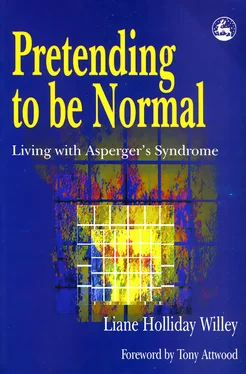Tony Attwood
Foreword by Lorna Wing
Jessica Kingsley Publishers, London, 1998.
ISBN 1 85302 577 1
This is the book that changed my life. One of the best layman’s book on Asperger’s Syndrome. A must-have not only for teachers and parents, but for anyone who is just learning to understand Asperger’s Syndrome.
Asperger Syndrome: A Guide for Educators and Parents
Brenda Smith Myles and Richard L. Simpson PRO-ED, Austin, Texas, 1998.
ISBN 0 89079 727 7
This book uses practical and easy to understand language to explore topics such as social enhancement, behavioral management, academic support and the impact AS has on families.
Autism and Asperger’s Syndrome
Uta Frith, ed.
Cambridge, Cambridge University Press, 1991.
ISBN 0 521386 08X
This book is quite technical, but it is a very important book that does much to explain Asperger’s research.
Higher Functioning Adolescents and Young Adults with Autism: A Teacher’s Guide
Ann Fullerton, ed., Joyce Stratton, Phyllis Coyne, and Carol Gray PRO-ED, Austin, Texas, 1996.
ISBN 0 890796 815
This insightful and helpful guide explores the issues facing adolescents and young adults, suggests how to adapt classroom materials and provides ideas for social skills training.
Sensory Integration and the Child
Jean Ayres
Western Psychological Services, Los Angeles, 1979.
ISBN 0 874241 588
A comprehensive and important resource for understanding and helping the person who experiences Sensory Integration dysfunction written by Jean Ayres, the founder of Sensory Integration therapy.
Teaching Your Child the Language of Social Success
Marshall P. Duke, Stephen Nowicki, and Elisabeth A. Martin Peachtree Publishers, LTD, Atlanta, Georgia, 1996.
ISBN 1 56145 126 6
A complete book filled with many useful and clear ideas for helping people, not just children, understand and use nonverbal communication and related language processes.
The Out-of-Sync Child: Recognizing and Coping with Sensory Integration Dysfunction
Carol Stock Kranowitz, Foreword by Larry B. Silver Perigee, 1998.
ISBN 0 39952 386 3
Though this book is not written solely for the person with Asperger’s Syndrome, it does contain information and suggestions about Sensory Integration Dysfunction that will apply to anyone facing those difficulties.
Thinking in Pictures and Other Reports of my Life with Autism
Temple Grandin
Doubleday, New York, 1995.
ISBN 0 67977 289 8
A very personal account of what autism is and what it is like to be affected by it.
Publishing companies and bookstores that offer Asperger’s Syndrome titles
Jessica Kingsley Publishers
In the UK:
116 Pentonville Road
London N19JB
England
Tel: +44 (0)171 833 2307
Fax: +44 (0)171 837 2917
In the US:
325 Chestnut Street
Philadelphia, PA
19106
USA
Tel: (toll free) 1 800 821 8312
Tel: 1 215 625 8900
Fax: 1 215 625 2940
http://www.jkp.com
Future Horizons
720 N. Fielder
Arlington, TX
76012
Tel: 1 800 489 0727
http://www.futurehorizons-autism.com/
Learning Disabilities Association
4156 Library Road
Pittsburgh, PA
15234
PRO-ED
8700 Shoal Creek Blvd
Austin, TX
78757
Tel: (toll free) 1-800 897 3202
Tel: 1-512 451 3246
Fax: 1-512 451 8542
http://www.proedinc.com/
Auditory Discrimination:The brain’s ability to separate important sounds (speaking voices) from extraneous sounds (traffic noise); locate where sounds are coming from (the front of the classroom or the rear of the classroom); maintain focus on essential tasks (studying) while ignoring outside noises that might interfere with concentration (music in the background). An inability to discriminate between sounds typically results in weak study skills.
Auditory Sensitivity:A disorder that interferes with an individual’s ability to analyze or make sense of sound information taken in through the ears. Persons affected by auditory sensitivity can find certain noises and sounds frightening, painful, distorted, confusing, and overwhelming to the point where everyday activities are impossible to enjoy and/or engage in.
Bilateral Coordination:The body’s ability to use its two sides cohesively and in coordination. Without bilateral coordination, a person is likely to experience difficulties in both fine motor movement activities such as using eating utensils, dressing or writing; and gross motor movement activities such as running, throwing, dancing or skipping. Poor reading skills are also often correlated with inadequate bilateral coordination.
Echolalia:A uniquely proficient and often remarkably sophisticated ability to parrot or mimic someone else’s voice, speaking pattern, words and/or mannerisms.
Obsessive Compulsive Disorder:A confused perception of reality which causes an individual to obsess on a perceived worry or thought (is the iron turned off, is the door locked. There are too many germs on this doorknob, etc.) that causes great anxiety and concern. The anxieties and concerns are only elevated for the person if they perform certain compulsive activities or mental acts (checking and rechecking a dozen times to be certain the iron is off and the door locked, or repetitive hand washing for sixty minutes, counting to ten over and over again, for example). In order for these patterns to be a true disorder, they must occur frequently enough to interfere with normal daily living and routines.
Olfactory Sensitivity:A disorder that interferes with an individual’s ability to cope with the sense of smell. Persons affected by olfactory sensitivity can find certain smells stressful, physically sickening, and completely repulsing. This can often make it difficult, if not impossible for the person to eat certain foods and/or concentrate in certain environments.
Pedantic Speech:Overly formal speech characterized by limited and literal interpretations of words.
Prosody:The vocal tone and qualities of speech. The «it’s not what you said, but how you said it» characteristics of spoken language that often leave people with Asperger’s Syndrome unable to accurately discern the meaning behind other individuals’ words, and unable to adequately express their own intended thoughts.
Sensory Integration:The process by which the brain organizes sensory input so one can interact with one’s environment effectively and meaningfully.
Sensory Integration Dysfunction:A marked inability to properly integrate sensory input, usually as a result of a neurological disorder or irregularity. Persons who experience sensory integration dysfunction often experience anxiety attacks, headaches, disorientation, confusion and problems in learning.
Spatial relation:A visual processing disorder that makes it difficult to position and coordinate objects in space.
Stim:A self-stimulating behavior (flapping hands, licking, spinning, rocking, etc.) designed to calm or de-stress.
Tactile Sensitivity:A condition that occurs when nerves under the surface of the skin miscommunicate information to the brain. As a result, an individual either overreacts or underreacts to any number of sensations including light and firm pressure, pain and temperature. A dysfunction in this ability can lead to an aversion to certain types of textures (wet, rough, sandy, slick, slimy, etc.) and certain behaviors (hair washing, hand shaking, craft making, pencil holding, etc.). Dysfunction can also expose an individual to stress, irritability, distractibility, and a desire for isolation.
Читать дальше












